How to Create a Cozy, Rainy-Day Routine Kids Will Love

Discover how to build a cozy, engaging rainy-day routine for kids. Packed with fun indoor ideas, mindful moments, and bonding time for families!
Embracing the Pitter-Patter: Why Rainy Days Can Be Magical
The sound of rain often brings a collective sigh from parents as outdoor plans dissolve. However, these pitter-patter days, frequently viewed as a challenge, hold the potential to be transformed into cherished opportunities for connection, creativity, and unforgettable cozy fun. It's not merely about filling hours; it's about weaving memories and strengthening bonds. Establishing a "rainy-day routine" can be the key. This isn't about a rigid, minute-by-minute schedule, but rather a comforting, predictable rhythm that infuses the day with joy and security. Such a routine can unlock numerous benefits, including deeper family connections, developmental boosts for children, and a precious chance for everyone to slow down and savor life's simpler pleasures.
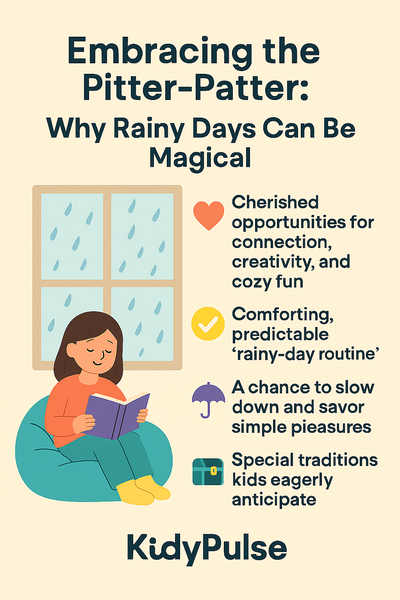
Rainy days inherently limit external activities, and this very limitation can be psychologically reframed as an invitation to explore internal, home-based joys and cultivate deeper connections within the family. When the usual hustle of external stimuli and commitments is naturally reduced, families have a unique chance to turn their focus inward, towards each other. This "forced" togetherness, if approached with a positive mindset, can evolve into intentional, high-quality time. This aligns with the understanding that strong parent-child bonds are foundational to a child's well-being and are nurtured through shared, positive experiences. Furthermore, by establishing a special approach to rainy days, parents can shift a child's perception from one of disappointment over cancelled plans to one of eager excitement. Children thrive on positive anticipation. If rainy days become consistently associated with unique, enjoyable activities—perhaps a special "Rainy Day Box" filled with novelties —the sound of rain can begin to trigger feelings of warmth and happy expectation rather than frustration.
The Comfort of Routine: Setting the Stage for Cozy Fun
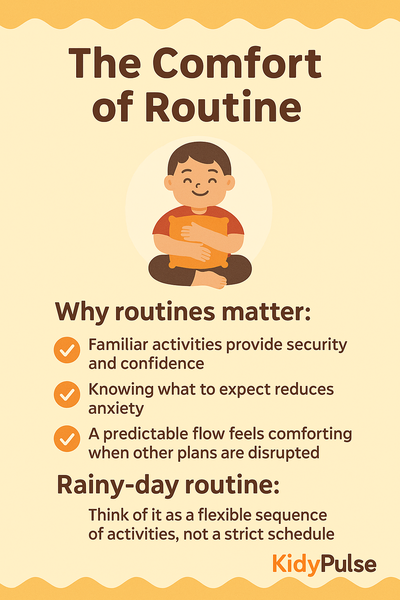
Routines offer a powerful sense of safety and predictability, an anchor that becomes especially comforting for children on unstructured days, such as those dictated by dreary weather. When the usual rhythms of school or outdoor play are disrupted, a familiar indoor flow can make all the difference.
- Why routines matter:
- Children tend to feel more confident and secure when their daily activities possess a degree of predictability and familiarity.
- A consistent daily schedule and step-by-step routines help children feel a sense of control over their environment, fostering feelings of safety and comfort. This is particularly crucial when external circumstances, like the weather, are beyond their control.
- Knowing what is happening now and what to expect next can significantly reduce anxiety and the likelihood of challenging behaviors. This is especially true when outdoor routines are suddenly off the table, as a lack of structure can sometimes lead to increased anxiousness or oppositional behaviors in children.
- Rainy-day routine as a flexible framework:
- It's important to emphasize that a rainy-day routine isn't intended to be a strict, minute-by-minute itinerary. Instead, it should be viewed as a predictable flow, a sequence of different types of activities (for example, a period of quiet play perhaps following lunch, or some active indoor games before a calm wind-down period).
- This gentle structure helps manage children's expectations and allows for smoother transitions between different parts of the day, minimizing potential friction and maximizing enjoyment.
On a day when the weather imposes limitations, a familiar indoor rhythm provides an essential emotional anchor, effectively reducing feelings of restlessness or uncertainty that children might experience. The research underscores that routines help children feel "safe, secure, and comfortable". When the external environment—in this case, rainy weather—is unpredictable or restrictive, an internal, predictable routine at home can counteract potential anxiety by reinforcing a sense of normalcy and control. Moreover, implementing even a loose rainy-day routine allows parents to be proactive in guiding the day's activities. This foresight means parents are better equipped to channel energy positively and introduce engaging options, rather than reactively trying to manage boredom or meltdowns as they arise. Knowing there's a "plan," however flexible, can also reduce parental stress, making the day more enjoyable for everyone. This proactive approach, with a planned (but adaptable) rainy day routine, can mitigate potential behavioral challenges by setting clear, positive expectations from the outset.
Building Your Rainy-Day Blueprint: Activities Kids Will Adore
Crafting a blueprint for rainy days involves curating a collection of activities that not only entertain but also nurture various aspects of a child's development. The following sections offer ideas categorized into different "blocks" of the day, ensuring a balanced and engaging flow. You can find more parents tips on our blog.
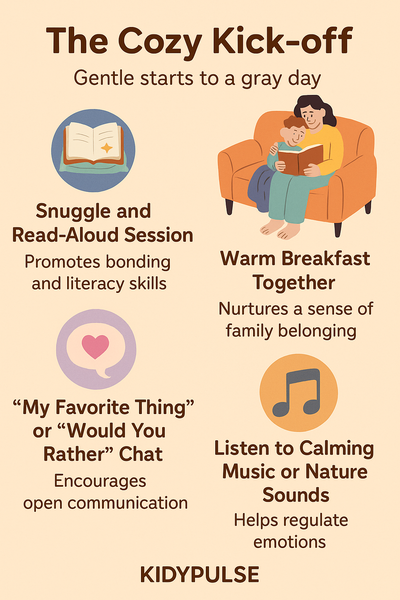
The Cozy Kick-off: Gentle Starts to a Gray Day
The aim here is to ease into the day with warmth, connection, and comfort, setting a positive and unhurried tone for the hours ahead. A cozy start can act as a deliberate transition ritual, acknowledging the shift from a potentially planned outdoor day to an indoor one, helping children adjust emotionally. This gentle beginning validates their presence at home and positively reframes the day, rather than letting it commence with a sense of loss over missed activities. This approach aligns with the positive parenting principle of "Enjoyment"—showing warmth and positivity from the get-go.
- Snuggle and Read-Aloud Session:
- Gathering favorite books and creating a cozy nest with cushions and blankets for a shared reading time is a wonderful way to begin.
- Benefits: This activity powerfully promotes literacy skills and sparks imagination. More importantly, it's a profound bonding experience. Sharing stories together also expands a child's vocabulary and enhances comprehension skills.
- Warm Breakfast Together:
- Consider preparing a slightly special breakfast, like pancakes, waffles, or oatmeal adorned with fun toppings that children can help choose or add.
- Benefits: Family meals, even simple breakfasts, are known to strengthen relationships and cultivate a child's sense of belonging within the family unit. It offers a natural opportunity to connect, share thoughts, and perhaps talk lightly about the day ahead.
- "My Favorite Thing" or "Would You Rather" Chat:
- Engage in a relaxed conversation game, perhaps while everyone is still in their pajamas, using prompts like "What's your favorite rainy day sound?" or "Would you rather be a superhero who can fly or one who can talk to animals?".
- Benefits: Such games encourage open communication and provide a window into a child's inner world, helping parents learn more about their thoughts, preferences, and developing personalities. It demonstrates a genuine interest in their thoughts and feelings, a key aspect of bonding.
- Listen to Calming Music or Nature Sounds (like the rain itself!):
- Creating a peaceful ambiance with gentle music or the soothing sounds of nature can be a lovely backdrop to the morning.
- Benefits: This can help in regulating emotions and provides a gentle, calming transition from the quiet of sleep to the activities of the day.

The Calm in the Storm: Essential Quiet Time Pursuits
Incorporating a period of lower-stimulation activity is vital for allowing everyone to rest, focus, and engage independently, providing a chance to recharge energies. Teaching children to engage in quiet, independent play is a valuable life skill that fosters self-regulation and nurtures their imagination. Rainy days present a perfect, unhurried opportunity to cultivate this capacity. In an often overstimulated world, the ability to be content and engaged with quieter, solo activities is crucial for well-rounded development. Quiet time isn't just about providing parents with a breather; it's an active process of nurturing a child's capacity for introspection, focused engagement, and the development of an "internal quiet voice". Explore some fun brain-boosting activities that can be done quietly.
- Puzzles Galore:
- Offer a variety of puzzles suited to different age levels, such as jigsaws, shape sorters, or simple logic puzzles.
- Benefits: Puzzles are excellent for developing critical problem-solving skills, enhancing fine motor dexterity, improving hand-eye coordination, strengthening memory, and teaching perseverance as children work towards a solution. Activities like puzzles, while seemingly simple, are powerhouses for cognitive development, enhancing skills critical for later academic learning by developing memory, planning, and problem-solving abilities.
- Independent Drawing, Coloring, or Sticker Books:
- Provide inviting materials like fresh paper, coloring books featuring favorite characters, or engaging sticker activity books, and designate a comfortable, quiet space for this activity.
- Benefits: These activities enhance focus and concentration, allow for creative expression, refine fine motor control, and can have a very calming and centering effect on children.
- Listening to Audiobooks or Story Podcasts:
- Select engaging stories or age-appropriate educational content available in audio format.
- Benefits: Listening to audiobooks helps improve vocabulary, pronunciation, and crucial auditory listening skills. It also enhances cognitive abilities such as focus, attention span, and memory retention. Furthermore, audiobooks make the world of stories and information accessible to all children, including those who may not yet be proficient readers or who learn best through auditory channels.
- "Secret Messages" with White Crayon and Watercolor:
- A wonderfully quiet and magical activity where messages or drawings are made with a white crayon on white paper, then revealed by painting over them with watercolors.
- Benefits: This activity cleverly combines art with an element of delightful surprise, encouraging fine motor skills through drawing and painting, and sparking creativity.
- Building with LEGOs or Magnetic Tiles:
- These construction toys lend themselves well to independent or quietly shared side-by-side play.
- Benefits: Building with LEGOs or magnetic tiles fosters spatial reasoning, encourages creative problem-solving, develops imaginative construction ideas, and refines fine motor skills.

Shake Off the Doldrums: Indoor Energy Burners
It's crucial to provide a healthy outlet for children's boundless physical energy, especially when outdoor play isn't an option. These activities not only improve mood but also help develop gross motor skills. Indoor active play isn't just about burning calories; it's vital for emotional regulation, particularly when children might feel confined or restless. Play, including physical activity, helps reduce stress and allows children to process difficult emotions. The release of endorphins during physical activity promotes a sense of well-being. When children can't run around outside, structured indoor movement can prevent pent-up energy from manifesting as frustration or challenging behaviors. Check out some winter activities for kids for more indoor ideas.
- Dance Party Extravaganza:
- Put on some upbeat, child-friendly music and encourage everyone to let loose and dance around the living room!.
- Benefits: This is fantastic for gross motor development, serves as an instant mood booster due to endorphin release , and provides a joyful outlet for self-expression through movement.
- Indoor Obstacle Course:
- Get creative using household items like pillows to crawl over, cushions to jump on, tunnels (if available) to crawl through, hoops to step into, and lines of masking tape on the floor to balance along or jump over.
- Benefits: This activity is excellent for developing gross motor skills, improving coordination and balance, encouraging problem-solving as they navigate the course, and practicing following directions.
- Balloon Volleyball/Tennis:
- Use a balloon as a soft, lightweight ball and hands or homemade paper plate paddles to bat it back and forth over an imaginary net (like the back of a sofa).
- Benefits: This game enhances hand-eye coordination, provides gentle yet active physical engagement, and is generally fun and manageable for children of all ages.
- Scavenger Hunt (Active Version):
- Hide a series of items (toys, specific books, or even written clues) around the house and have children race to find them.
- Benefits: Scavenger hunts stimulate problem-solving abilities and observation skills as children decipher clues or search for hidden objects. They also encourage physical movement as children explore different areas of the home. If done collaboratively, they can foster teamwork. Such games engage children in problem-solving and critical thinking within a playful, motivating context, enhancing cognitive skills and memory retention.
- Hide and Seek:
- This timeless classic almost always delights children and requires no special equipment.
- Benefits: Hide and seek naturally encourages movement, promotes strategic thinking as children choose hiding spots or search for others, and helps them practice turn-taking.
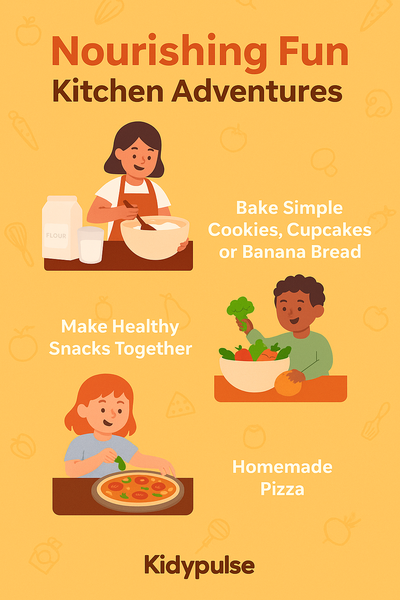
Nourishing Fun: Kitchen Adventures
Engaging children in the process of food preparation is a wonderfully enriching experience. It not only teaches them valuable life skills but also fosters a positive relationship with food and creates delicious, shared moments of connection. The kitchen offers a rich, multi-sensory learning environment where abstract concepts, such as mathematics and science, become tangible, relevant, and exciting. Cooking engages touch, taste, smell, and observation, thereby expanding children's perspectives and language. For instance, measuring ingredients makes fractions concrete, and watching dough rise demonstrates a scientific process in action. This hands-on, sensory learning is highly effective for children. Explore our recipes section for inspiration.
- Bake Simple Cookies, Cupcakes, or Banana Bread:
- Choose age-appropriate recipes where children can actively participate in tasks like measuring ingredients (with supervision), mixing batter, spooning dough, or decorating the finished treats.
- Benefits: Baking together is a fantastic way to teach early math skills (measuring, counting), basic science concepts (how ingredients interact and transform with heat), and fine motor skills (stirring, scooping, pouring). It also cultivates patience as they wait for items to bake and the importance of following instructions. Successfully creating something delicious significantly boosts a child's confidence.
- Make Healthy Snacks Together:
- Prepare nutritious and appealing snacks. Examples include Crispy Veggie Patties, where kids can help mix and shape; a colorful Fruity Delight (fruit salad), where they can assist with washing and (if age-appropriate) cutting softer fruits; or Sweet Potato Sticks, which they can help toss with oil and seasonings before baking. Find more healthy recipes even picky eaters will devour.
- Benefits: Involving children in the preparation of healthy snacks encourages them to try new foods and flavors. It's an excellent opportunity to teach them about nutrition for growing kids in a practical way and provides a profound sense of accomplishment. It's a well-observed phenomenon that children are often more willing to eat foods they have had a hand in making. Cooking together is also an act of care and can strengthen family bonds by creating shared responsibility for nourishing the family. When children participate, they contribute to the family's well-being, fostering a sense of belonging and value.
- Homemade Pizza:
- Use pre-made crusts or make simple dough, then let children choose their favorite healthy toppings and assemble their own mini pizzas.
- Benefits: This is a fun, creative activity that most children adore. It teaches basic cooking skills and allows for individual expression through topping choices.
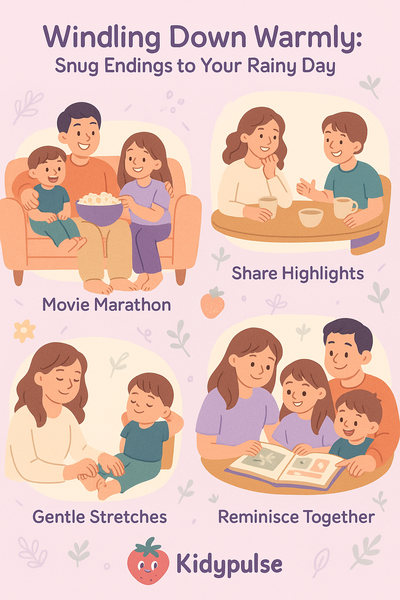
Winding Down Warmly: Snug Endings to Your Rainy Day
As the day draws to a close, it's beneficial to transition calmly towards evening routines or bedtime. This period should reinforce connection and promote relaxation, leaving everyone with a sense of contentment. A warm wind-down acts as a closing ritual for the special rainy day, helping children transition smoothly to the next part of their day (e.g., dinner, bedtime) with positive feelings. Just as a cozy start helps begin the day on a good note, a calm ending reinforces the positive feelings associated with the day, provides closure, and allows for a final moment of connection, solidifying the day's positive experiences in their memory. This aligns well with the "Enjoyment" aspect of positive parenting, ensuring the day ends on a loving note.
- Family Movie Marathon with Popcorn:
- Allow each family member to pick a short, age-appropriate movie or a favorite TV episode, or settle in for a longer family-friendly feature film. Don't forget the popcorn!.
- Benefits: This offers shared enjoyment, a chance to relax together, and plenty of opportunities for cuddles on the couch.
- Sharing Favorite Parts of the Day:
- Engage in a simple reflection activity where each person shares one or two things they enjoyed most about the rainy day.
- Benefits: This encourages gratitude, promotes communication, and helps children process and articulate their experiences. It effectively uses the "Reflection" PRIDE skill, showing children their thoughts and feelings are heard and valued.
- Gentle Stretching or "Family Spa" Moments:
- Engage in some simple, gentle stretches together, or create "spa" moments like giving light foot rubs, hand massages, or even just brushing each other's hair.
- Benefits: These activities promote physical relaxation, offer comforting physical touch, and deepen affectionate connections within the family.
- Looking Through Old Photos or Home Movies:
- A quiet, often nostalgic activity that involves revisiting cherished family memories.
- Benefits: This can spark wonderful conversations, strengthen family identity and shared history, and often leads to much laughter and warmth as you reminisce together.
The Secret Weapon: Crafting a "Rainy Day Surprise Box"
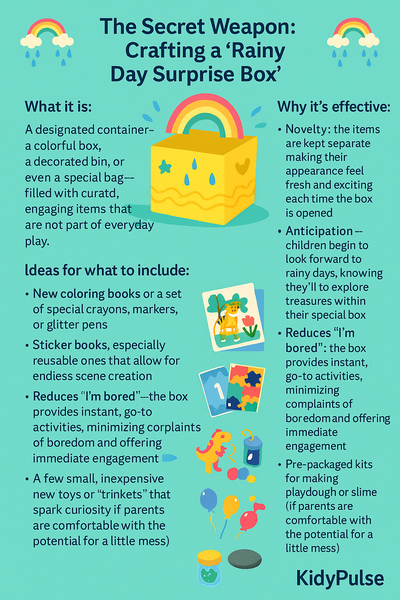
A pre-prepared box filled with special items, exclusively brought out on rainy days, can instantly elevate the mood and transform an ordinary day indoors into a special occasion. This simple strategy taps into powerful psychological principles of scarcity and novelty. Because the items within the box are "special" and only accessible during specific, less frequent times (i.e., rainy days), they hold significantly more allure and perceived value than everyday toys. This heightened anticipation can genuinely transform a child's attitude towards an otherwise potentially gloomy day, turning disappointment into excitement.
- What it is: A designated container—a colorful box, a decorated bin, or even a special bag—filled with a curated collection of simple, engaging items that are not part of everyday play.
- Why it's effective:
- Novelty: The items are kept separate from regular toys and activities, making their appearance feel fresh and exciting each time the box is opened.
- Anticipation: Children will begin to look forward to rainy days, knowing they'll get to explore the treasures within their special box.
- Reduces "I'm bored": The box provides instant, go-to activities, minimizing complaints of boredom and offering immediate engagement.
- Ideas for what to include: The key is to choose items that are engaging and can ideally be used with minimal supervision, empowering independent play.
- New coloring books or a set of special crayons, markers, or glitter pens
- Sticker books, especially reusable ones that allow for endless scene creation
- A simple new puzzle appropriate for their age, or a deck of cards for simple games
- Small, unique craft supplies: colorful pipe cleaners, an assortment of pom-poms, googly eyes, special textured paper, or craft foam shapes
- A few small, inexpensive new toys or "trinkets" that spark curiosity
- Pre-packaged kits for making playdough or slime (if parents are comfortable with the potential for a little mess)
- Balloons for indoor games
- Sensory items like homemade "sensory bottles" (clear bottles filled with water, glitter, small objects) or items with interesting textures like soft fabric scraps or smooth stones
The "Rainy Day Box" not only provides entertainment but also empowers independent play through curated choices. The box offers a pre-selected set of appealing options, making it easier for children to choose an activity and engage by themselves. This not only fosters autonomy and concentration in the child but also gives parents a welcome breather.
More Than Just Fun: The Developmental Perks of Your Rainy-Day Routine
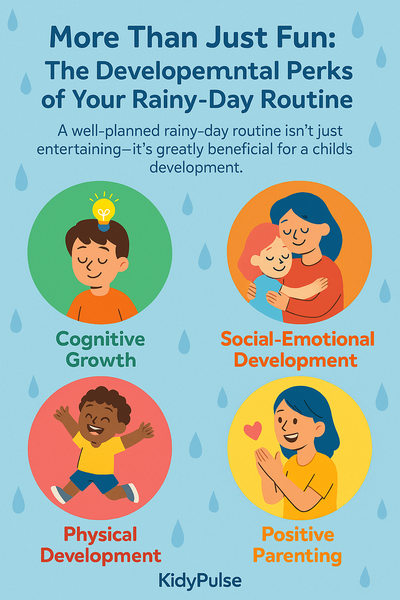
The carefully chosen activities woven into a rainy-day routine are far more than just pleasant time-fillers; they actively and significantly support a child's holistic development across multiple domains. A rainy-day routine rich in varied, engaging activities and positive interactions doesn't just offer isolated benefits; it creates a compounding effect on a child's overall development and well-being. The combination of cognitive stimulation (like puzzles and building), creative expression (through art and imaginative play), physical release (via dance or obstacle courses), emotional connection (fostered by shared activities and conversations), and the underlying security of a predictable routine, all reinforced by positive parenting approaches, creates a powerful synergy. Each positive experience builds upon the last, strengthening the child's skills, bolstering their confidence, and deepening the crucial parent-child bond.
- Cognitive Growth:
- Problem-solving skills are honed through activities like figuring out puzzles , constructing stable forts , and deciphering clues in scavenger hunts.
- Memory and concentration are actively engaged when working on puzzles , listening attentively to audiobooks , and focusing on detailed creative tasks.
- Language and literacy development is boosted through shared reading, collaborative storytelling, listening to audiobooks which model fluent reading and introduce new vocabulary , creating dialogue for puppet shows , and even following written recipes during cooking adventures.
- Early math and science concepts are naturally introduced and explored when cooking or baking (measuring ingredients, observing chemical reactions) , and during building activities like LEGO construction or fort engineering.
- Social-Emotional Development:
- Self-esteem and confidence flourish as children successfully complete tasks, express themselves creatively , and contribute to family activities like cooking.
- Emotional expression and regulation are supported through imaginative and creative play, which allows children to explore and process feelings , and through physical activity, which can be a healthy outlet for pent-up emotions.
- Cooperation and turn-taking skills are practiced during board games, collaborative building projects, and team-based scavenger hunts.
- Empathy and understanding can be nurtured through discussing characters and situations in stories, and through engaging in role-play scenarios.
- Crucially, these shared positive experiences significantly strengthen the parent-child bond, which is the bedrock of emotional security. A secure attachment relationship is a primary protective factor for a child's mental health and forms the foundation for developing resilience in the face of life's challenges.
- Physical Development:
- Fine motor skills and dexterity are refined through activities like drawing, coloring, cutting with scissors, manipulating puzzle pieces , molding playdough, and engaging in various crafts.
- Gross motor skills are developed and energy is expended through lively dance parties, navigating indoor obstacle courses, and other active games.
- Hand-eye coordination is improved by activities such as completing puzzles , playing balloon tennis or volleyball , and engaging in craftwork that requires precise movements.
- The Role of Positive Parenting (PRIDE Skills): The focused, often one-on-one or small-group nature of rainy-day activities provides an ideal setting for parents to consciously practice and model positive parenting techniques, such as the PRIDE skills. Without the usual rush of errands or external commitments, parents can be more present and intentional in their interactions.
- Praise: Acknowledging effort, cooperation, and positive behaviors ("That was wonderful how you shared the blue crayon!" or "Good job working together on that fort!").
- Reflection: Actively listening and repeating back or elaborating on what a child says to show understanding ("So you think the tower needs to be even taller to reach the sky?").
- Imitation: Joining in their play in a similar manner, which makes children feel their activities are important ("This fort looks amazing! Can I help add a window here, just like you did?").
- Description: Narrating their actions like a sportscaster, which shows attention and can build vocabulary ("You are very carefully placing that red block on top of the green one.").
- Enjoyment: Showing genuine warmth, enthusiasm, and pleasure in spending time together ("This is so much fun building and laughing with you!").
- Why it matters: Consistently using these skills makes all activities more engaging and powerfully reinforces the positive behaviors, skills, and connections that parents wish to nurture. It sends the crucial message to children that they are loved, they are good, and they matter.
Making Memories: Final Tips for a Truly Loveable Rainy Day
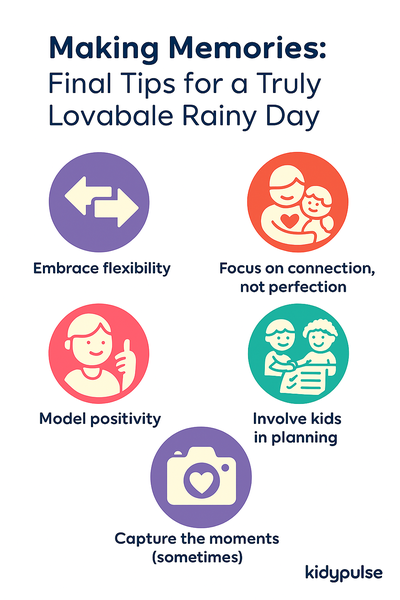
The true magic of a cozy, rainy-day routine lies not just in the activities themselves, but in the spirit and intention with which they are approached. The atmosphere created is paramount. When children are involved in planning their rainy-day activities, their engagement and enjoyment often skyrocket because they feel a sense of agency and that their preferences truly matter. Allowing children to choose (within reasonable, parent-guided options) fosters independence and intrinsic motivation. This co-creation makes the routine "theirs" too, not just something imposed by adults, aligning with positive parenting principles that respect the child and their ideas.
- Embrace Flexibility: While a routine provides a comforting structure, it's important to remain open to detours and spontaneous shifts. If a child is deeply engrossed in a particular activity or excitedly suggests a new idea, going with the flow can lead to even more joyful moments. The ultimate goal is shared happiness, not rigid adherence to a pre-set schedule.
- Focus on Connection, Not Perfection: The most vital ingredient for a successful rainy day is parental presence and positive engagement. It's easy to get caught up in trying to make activities "Pinterest-perfect," but children will remember the warmth and connection far more than a flawless craft or perfectly executed game. Being in the moment is key.
- Involve Kids in Planning: Whenever possible, let children have a say in choosing some of the day's activities or selecting items to go into the "Rainy Day Surprise Box." This gives them a sense of ownership and significantly increases their excitement and investment in the day. This aligns with the principle of letting a child lead during playtime, fostering their autonomy.
- Model Positivity: A parent's attitude towards the rainy day is highly contagious. Framing it as a special opportunity for unique indoor adventures, rather than a day of being "stuck," can transform the entire family's experience. Showing enjoyment models positivity for children.
- Parental Enjoyment & Self-Care Matters: It's much harder to create a cozy, loving atmosphere if parents are feeling stressed, resentful, or depleted. Finding ways to genuinely enjoy these shared moments is important. Equally crucial is remembering to take small breaks if needed. A parent's ability to be present and enjoy these routines is significantly enhanced by their own self-care and positive mindset, which then positively impacts the child's experience. Giving oneself praise for doing their best is also a part of this.
- Capture the Moments (Sometimes): A quick photograph or a short video can be a lovely memento of a fun rainy day. However, it's wise to ensure that documenting the day doesn't overshadow the importance of being fully present and engaged in the actual experience with the children.
Conclusion: Let the Rain Bring You Closer
Rainy days, with their gentle insistence on indoor quietude, need not be a source of parental dread or childhood boredom. Instead, with a touch of thoughtful planning and a heart open to simple joys, they can become some of a family's most cherished and connecting times. These indoor adventures are precious opportunities for shared laughter, collaborative learning, and the significant strengthening of family bonds.
The true beauty of a well-crafted rainy-day routine lies in its power to transform "stuck inside" days into "snuggled in" days, filled with warmth, creativity, and meaningful interaction. The memories created during these intentional, cozy times contribute profoundly to a child's overall sense of security, belonging, and positive family identity, a legacy that endures long after the rain has stopped and the sun shines once more. These consistent, positive, shared experiences become integral parts of a child's "internal working model" of relationships and family life, fostering an emotional security that can support them throughout their lives. So, the next time the clouds gather, consider it an invitation to let the rain bring the family closer. For more parenting insights, visit our blog and learn more about us. If you have any questions, our FAQ page might have the answers.
Sourced used in this blog :
The Rainy Day Box - Talk Play Grow
Scavenger Hunts: A Perfect Learning Exercise - TeachingTimes
6 Reasons Why You Should Be Using Scavenger Hunts With Your Toddler This Summer!
The Psychology of Fort Building: Why It's More than Just Child's Play
The Whole Child - For Early Care Providers - Creativity and Play - PBS
How play strengthens your child's mental health | UNICEF Parenting
6 Baking Ideas and Inspirations for Kids at Home on a Rainy Day - Baker's Secret
Snow Day Activities: 55 Fun Things to Do on a Snow Day Indoors | Mommy Poppins
10 Creative Indoor Activities for Rainy Days - Just Children
Top 20 Rainy Day Activities | Sunshine House
Managing Vacation Time: Preparing for a Jolly Holiday Season with Kids
8 Activities for Kids to Burn Energy Indoors - New Horizon Academy
The Importance of Schedules and Routines | HeadStart.gov
A Philadelphia Private School ... - The Waldorf School of Philadelphia
65 Fun Ways to Spend a Rainy Day With Kids - Parents

Comments
No comments yet. Be the first to leave a comment!